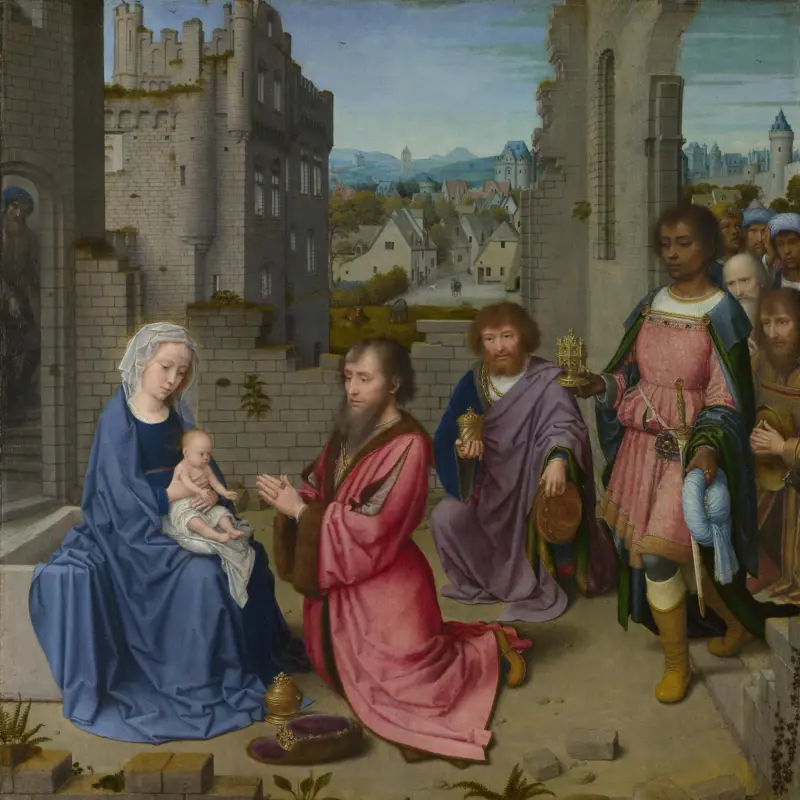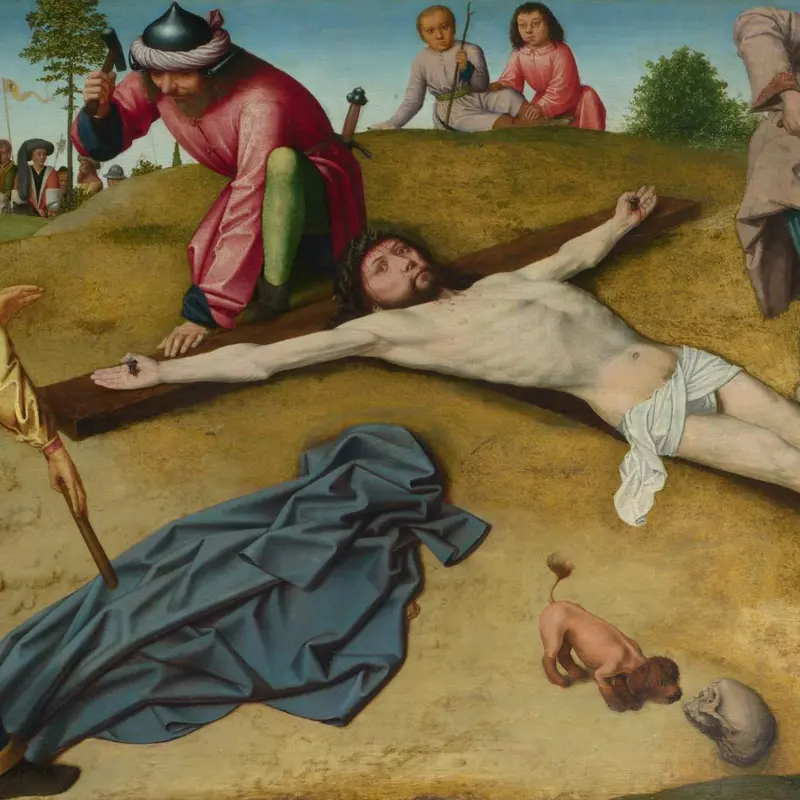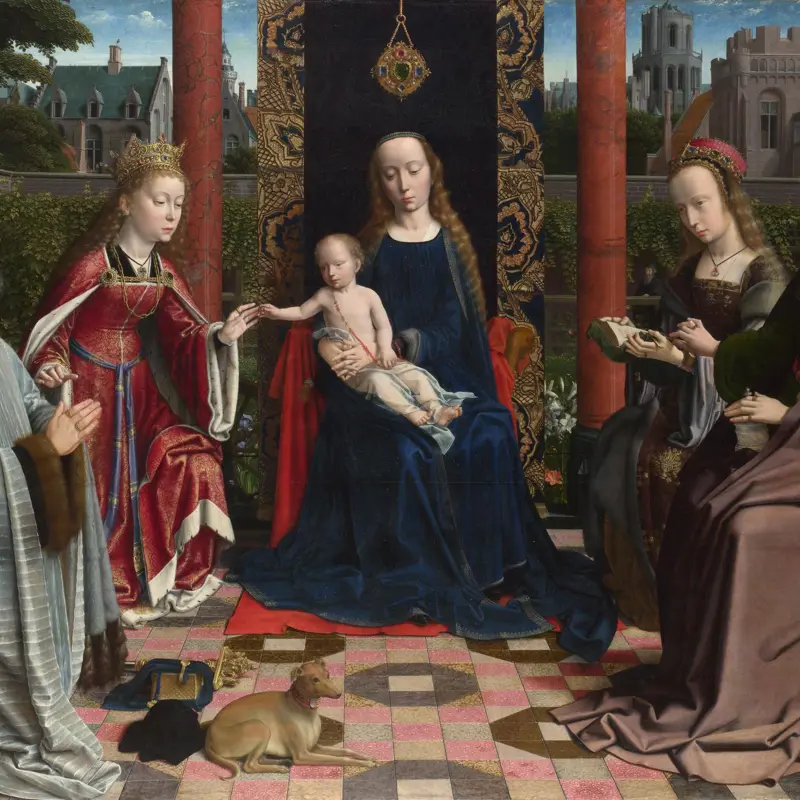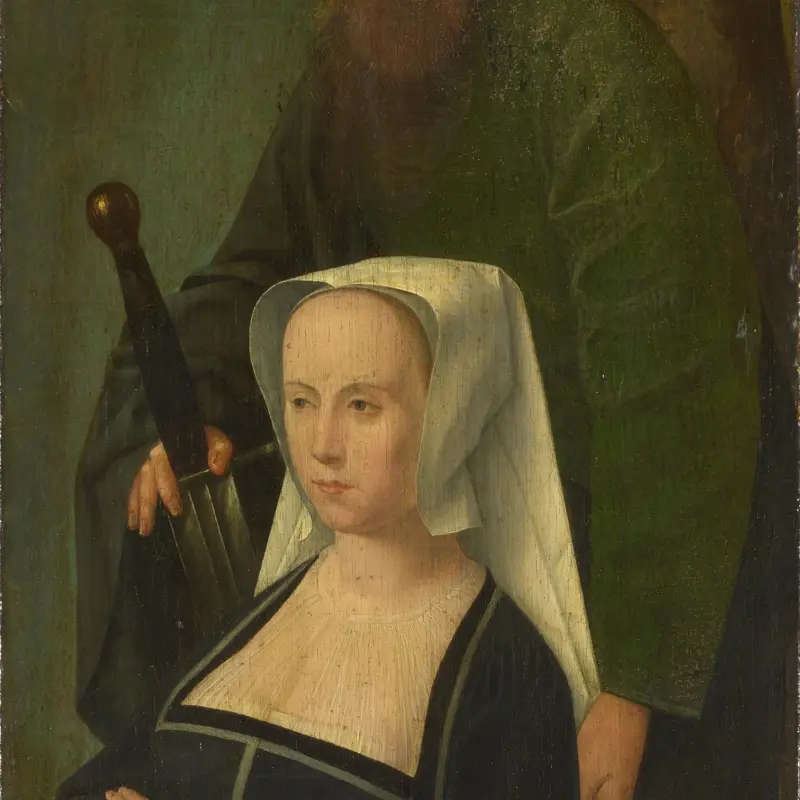Gerard David, 'Canon Bernardijn Salviati and Three Saints', after 1501
About the work
Overview
A thin-faced man kneels in prayer, surrounded by three saints. This is Bernardijn Salviati, illegitimate son of a Florentine merchant, and canon of the Collegiate Church of Saint Donatian in Bruges. The saints are, from left to right: Martin of Tours, with the beggar he gave his cloak to on the road behind him; Bernardijn’s name saint, the Franciscan Bernardino of Siena, in a grey habit; and Donatian, patron of Bernardijn’s church.
The panel, which originally had an arched top, was almost certainly part of a diptych (a painting in two parts) commissioned for the chapel of Saint John the Baptist and Mary Magdalene at Saint Donatian’s, which Bernardijn was given permission to restore in January 1501. The other panel probably showed the Crucifixion (Staatliche Museen, Berlin). On the back of our panel is a ruined picture apparently showing the resurrected Christ at an open window.
Key facts
Details
- Full title
- Canon Bernardijn Salviati and Three Saints
- Artist
- Gerard David
- Artist dates
- active 1484; died 1523
- Date made
- after 1501
- Medium and support
- oil on wood
- Dimensions
- 103.4 × 94.3 cm
- Acquisition credit
- Bequeathed by William Benoni White, 1878
- Inventory number
- NG1045
- Location
- Room 53
- Collection
- Main Collection
- Previous owners
- Frame
- 19th-century Italian Frame
Provenance
Additional information
Text extracted from the ‘Provenance’ section of the catalogue entry in Lorne Campbell, ‘National Gallery Catalogues: The Fifteenth Century Netherlandish Schools’, London 1998; for further information, see the full catalogue entry.
Bibliography
-
1731J.F. Foppens and J. Beernaerts, Compendium chronologicum episcoporum brugensium, Bruges 1731
-
1794Acta sanctorum, octobris, Tongerlo 1794
-
1801J. Britton and E.W. Brayley, The Beauties of England and Wales, 19 vols, London 1801
-
1817T.B. Brydges, List of Pictures at the Seat of T. B. Brydges Barrett, Esq.: At Lee Priory, in the County of Kent, n.p. 1817
-
1825J.P. Neale, The Views of the Seats of Noblemen and Gentlemen in England, Wales, Scotland, and Ireland, London 1825
-
1861J. Gailliard, Inscriptions funéraires et monumentales de la Flandre occidentale avec des données historiques et généalogiques: Arrondissements de Bruges, Bruges 1861
-
1866W.H.J. Weale, 'Gerard David II: Sa vie et ses œuvres authentiques', Gazette des beaux-arts, XXI, 1866, pp. 489-501
-
1866W.H.J. Weale, 'Le couvent des sœurs Notre-Dame dit de Sion à Bruges', Le Beffroi, III, 1866, pp. 334-70
-
1875L. Gilliodts-van Severen, Coutumes des pays et comté de Flandre. Quartier de Bruges. Coutume de la ville de Bruges, Brussels 1875
-
1881National Gallery, Descriptive and Historical Catalogue of the Pictures in the National Gallery: Foreign Schools, London 1881
-
1892H. Dussart, Fragments inédits de Romboudt de Doppere, Bruges 1892
-
1895W.H.J. Weale, Gerard David: Painter and Illuminator, London 1895
-
1905S. Reinach, Répertoire de peintres du Moyen Âge et de la Renaissance (1250-1580), 4 vols, Paris 1905
-
1905H. Walpole, The Letters of Horace Walpole, vol. 15, ed. P. Toynbee, London 1905
-
1924M.J. Friedländer, Die altniederländische Malerei, 14 vols, Berlin 1924
-
1929F. Dülberg, Niederländische Malerei der Spätgotik und Renaissance, Berlin 1929
-
1937H. Walpole, Horace Walpole Correspondence, ed. W.S. Lewis, 48 vols, New Haven 1937
-
1938R.A. Parmentier, Indices op de Brugsche Poorterboeken, 2 vols, Bruges 1938
-
1940Decembris propylaeum, Brussels 1940
-
1941E. Viviani della Robbia, 'Italiani nel mondo, un mercnate a Bruges nel sec. XV', Illustrazione toscana e dell'Etruria, IX, 1941, pp. 8-15
-
1945Davies, Martin, National Gallery Catalogues: Early Netherlandish School, London 1945
-
1946J. Wils, Matricule de l'université de Louvain, Brussels 1946
-
1952H. Honour, 'A House of the Gothic Revival', Country Life, CXI, 1952, pp. 1665-6
-
1953M. Davies, The National Gallery, London, Les Primitifs flamands. I, Corpus de la peinture des anciens Pay-Bas méridionaux au quinzième siècle 3, 2 vols, Antwerp 1953
-
1955Davies, Martin, National Gallery Catalogues: Early Netherlandish School, 2nd edn (revised), London 1955
-
1962R. Aprile, Bibliotheca sanctorum, Rome 1962
-
1962R. Doehaerd, Études anversoises: Documents sur le commerce international à Anvers, 1488–1514, Paris 1962
-
1962R.H. Goodsall, 'Lee Priory and the Brydges Circle', Archaeologia Cantiana, LXXVII, 1962, pp. 1-26
-
1963R. de Roover, The Rise and Decline of the Medici Bank, 1397-1494, Harvard Studies in Business History 21, Cambridge MA 1963
-
1963A. Viaene, 'Een Brugs vademecum voor de Rome- en Jeruzalemvaarder samengesteld door Rombout de Doppere 1491', Handelingen van het Genootschap voor Geschiedenis / Annales de la Société d'Emulation de Bruges, C, 1963, pp. 301-22
-
1967M.J. Friedländer, Early Netherlandish Painting, eds N. Veronée-Verhaegen and H. Pauwels, trans. H. Norden, 14 vols, Leiden 1967
-
1968C.D. Cuttler, Northern Painting from Pucelle to Bruegel: Fourteenth, Fifteenth and Sixteenth Centuries, New York 1968
-
1975D.G. Scillia, Gerard David and Manuscript Illumination in the Lowlands, Phd Thesis, Case Western Reserve University 1975
-
1976E. Heller, Das altniederländische Stiferbild, Tuduv Studien, Reihe Kulturwisenschaftend, Phd Thesis, Munich 1976
-
1976V. Vermeersch, Grafmonumenten te Brugge Vor 1578, Bruges 1976
-
1981A. Dewitte, 'Juweleninventarissen van de Brugse collegiale Sint-Donaas (1409-1538)', in M. Smeyers (ed.), Bijdragen tot de geschiedenis van de kunst der Nederlanden opgedragen aan Prof. Em. Dr J.K. Steppe, Louvain 1981, pp. 29-44
-
1985P. Hurtubise, Une famille-temoin: Les Salviati, Studi e testi 309, Vatican City 1985
-
1986R. Genaille, 'Le paysage flamand et wallon au XVIe siècle', Jaarboek Koninklijk Museum voor Schone Kunsten Antwerpen, 1986
-
1987Davies, Martin, National Gallery Catalogues: The Early Netherlandish School, 3rd edn, London 1987
-
1987D. de Vos, 'Gerard David', in Nationaal biografisch woordenboek, Brussels 1987, vol. 12
-
1994R. Strohm, 'Music, Ritual and Painting in Fifteenth-Century Bruges', in D. de Vos (ed.), Hans Memling: Essays, Bruges 1994, pp. 30-44
-
1998Campbell, Lorne, National Gallery Catalogues: The Fifteenth Century Netherlandish Paintings, London 1998
-
2001
C. Baker and T. Henry, The National Gallery: Complete Illustrated Catalogue, London 2001
-
2005J. Snyder, Northern Renaissance Art: Painting, Sculpture, the Graphic Arts from 1350 to 1575, ed. L. Silver, New Jersey 2005
About this record
If you know more about this work or have spotted an error, please contact us. Please note that exhibition histories are listed from 2009 onwards. Bibliographies may not be complete; more comprehensive information is available in the National Gallery Library.








